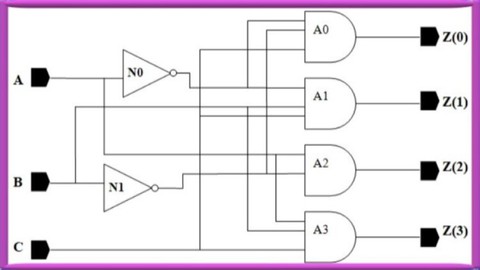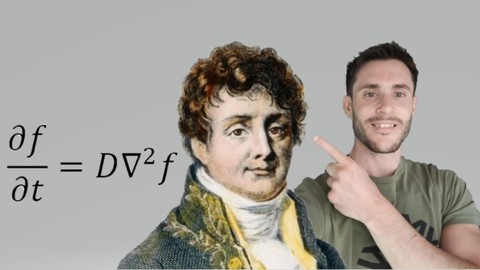Master Discrete Math 2020: More Than 5 Complete Courses In 1
Loại khoá học: Math
Learn Discrete Mathematics In This Course: 300+ Lectures/Quizzes And 30 Assignments With 500+ Questions & Solutions
Mô tả
MASTER DISCRETE MATH 2020 IS SET UP TO MAKE DISCRETE MATH EASY:
This 461-lesson course includes video and text explanations of everything from Discrete Math, and it includes 150 quizzes (with solutions!) after each lecture to check your understanding and an additional 30 workbooks with 500+ extra practice problems (also with solutions to every problem!), to help you test your understanding along the way.
This is the most comprehensive, yet straight-forward, course for Discrete Mathematics on Udemy! Whether you have never been great at mathematics, or you want to learn about the advanced features of Discrete Math, this course is for you! In this course we will teach you Discrete Mathematics.
Master Discrete Math 2020 is organized into the following 24 sections:
Mathematical Statements
Set Theory
Functions And Function Notation
Relations
Additive And Multiplicative Principles
Binomial Coefficients
Combinations And Permutations
Combinatorial Proofs
Advanced Counting Using The Principle Of Inclusion And Exclusion
Describing Sequences
Arithmetic And Geometric Sequences
Polynomial Fitting
Solving Recurrence Relations
Mathematical Induction
Propositional Logic
Proofs And Proving Techniques
Graph Theory Definitions
Trees
Planar Graphs
Coloring Graphs
Euler Paths And Circuits
Matching In Bipartite Graphs
Generating Functions
Number Theory
AND HERE'S WHAT YOU GET INSIDE OF EVERY SECTION:
Videos: Watch engaging content involving interactive whiteboard lectures as I solve problems for every single math issue you’ll encounter in discrete math. We start from the beginning... I explain the problem setup and why I set it up that way, the steps I take and why I take them, how to work through the yucky, fuzzy middle parts, and how to simplify the answer when you get it.
Notes: The notes section of each lesson is where you find the most important things to remember. It’s like Cliff Notes for books, but for Discrete Math. Everything you need to know to pass your class and nothing you don’t.
Quizzes: When you think you’ve got a good grasp on a topic within a lecture, test your understanding with a quiz. If you pass, great! If not, you can review the videos and notes again or ask for help in the Q&A section.
Workbooks: Want even more practice? When you've finished the section, you can review everything you've learned by working through the bonus workbooks. These workbooks include 500+ extra practice problems (all with detailed solutions and explanations for how to get to those solutions), so they're a great way to solidify what you just learned in that section.
YOU'LL ALSO GET:
Lifetime access to a free online Discrete Math textbook
Lifetime access to Master Discrete Math 2020
Friendly support in the Q&A section
Udemy Certificate of Completion available for download
So what are you waiting for? Learn Discrete Math in a way that will advance your career and increase your knowledge, all in a fun and practical way!
HERE'S WHAT SOME STUDENTS OF MASTER DISCRETE MATH 2020 HAVE TOLD ME:
“The course covers a lot of Discrete Math topics helping someone like me who knew nothing about discrete mathematics. The course structure is well-arranged and the explanation for every topic is given in a very simple manner. It helped me a lot. I really want to thank the instructor for helping me to explore this amazing world of Discrete Math." - Shibbu J.
"This course is great. Discrete Math is difficult, but Amour's explanations are very clear. I have bought other math courses by Kody Amour and all of them are great, well-explained and easy to follow." - Susan M.
"Very comprehensive course and exceptionally articulated." - Faisal Abbas
"Best course for Discrete Maths on Udemy." - Vatsal P.
Will this course give you core discrete math skills?
Yes it will. There are a range of exciting opportunities for students who take Discrete Math. All of them require a solid understanding of Discrete Math, and that’s what you will learn in this course.
Why should you take this course?
Discrete Mathematics is the branch of mathematics dealing with objects that can assume only distinct, separated values. Discrete means individual, separate, distinguishable implying discontinuous or not continuous, so integers are discrete in this sense even though they are countable in the sense that you can use them to count. The term “Discrete Mathematics” is therefore used in contrast with “Continuous Mathematics,” which is the branch of mathematics dealing with objects that can vary smoothly (and which includes, for example, calculus). Whereas discrete objects can often be characterized by integers, continuous objects require real numbers.
Almost all middle or junior high schools and high schools across the country closely follow a standard mathematics curriculum with a focus on “Continuous Mathematics.” The typical sequence includes:
Pre-Algebra -> Algebra 1 -> Geometry -> Algebra 2/Trigonometry -> Precalculus -> Calculus Multivariable Calculus/Differential Equations
Discrete mathematics has not yet been considered a separate strand in middle and high school mathematics curricula. Discrete mathematics has never been included in middle and high school high-stakes standardized tests in the USA. The two major standardized college entrance tests: the SAT and ACT, do not cover discrete mathematics topics.
Discrete mathematics grew out of the mathematical sciences’ response to the need for a better understanding of the combinatorial bases of the mathematics used in the real world. It has become increasingly emphasized in the current educational climate due to following reasons:
Many problems in middle and high school math competitions focus on discrete math
Approximately 30-40% of questions in premier national middle and high school mathematics competitions, such as the AMC (American Mathematics Competitions), focus on discrete mathematics. More than half of the problems in the high level math contests, such as the AIME (American Invitational Mathematics Examination), are associated with discrete mathematics. Students not having enough knowledge and skills in discrete mathematics can’t do well on these competitions. Our AMC prep course curriculum always includes at least one-third of the studies in discrete mathematics, such as number theory, combinatorics, and graph theory, due to the significance of these topics in the AMC contests
Discrete Mathematics is the backbone of Computer Science
Discrete mathematics has become popular in recent decades because of its applications to computer science. Discrete mathematics is the mathematical language of computer science. Concepts and notations from discrete mathematics are useful in studying and describing objects and problems in all branches of computer science, such as computer algorithms, programming languages, cryptography, automated theorem proving, and software development. Conversely, computer implementations are tremendously significant in applying ideas from discrete mathematics to real-world applications, such as in operations research.
The set of objects studied in discrete mathematics can be finite or infinite. In real-world applications, the set of objects of interest are mainly finite, the study of which is often called finite mathematics. In some mathematics curricula, the term “finite mathematics” refers to courses that cover discrete mathematical concepts for business, while “discrete mathematics” courses emphasize discrete mathematical concepts for computer science majors.
Discrete math plays the significant role in big data analytics.
The Big Data era poses a critically difficult challenge and striking development opportunities: how to efficiently turn massively large data into valuable information and meaningful knowledge. Discrete mathematics produces a significant collection of powerful methods, including mathematical tools for understanding and managing very high-dimensional data, inference systems for drawing sound conclusions from large and noisy data sets, and algorithms for scaling computations up to very large sizes. Discrete mathematics is the mathematical language of data science, and as such, its importance has increased dramatically in recent decades.
IN SUMMARY, discrete mathematics is an exciting and appropriate vehicle for working toward and achieving the goal of educating informed citizens who are better able to function in our increasingly technological society; have better reasoning power and problem-solving skills; are aware of the importance of mathematics in our society; and are prepared for future careers which will require new and more sophisticated analytical and technical tools. It is an excellent tool for improving reasoning and problem-solving abilities.
Starting from the 6th grade, students should some effort into studying fundamental discrete math, especially combinatorics, graph theory, discrete geometry, number theory, and discrete probability. Students, even possessing very little knowledge and skills in elementary arithmetic and algebra, can join our competitive mathematics classes to begin learning and studying discrete mathematics.
Does the course get updated?
It’s no secret how discrete math curriculum is advancing at a rapid rate. New, more complex content and topics are changing Discrete Math courses across the world every day, meaning it’s crucial to stay on top with the latest knowledge.
A lot of other courses on Udemy get released once, and never get updated. Learning from an outdated course and/or an outdated version of Discrete Math can be counter productive and even worse - it could teach you the wrong way to do things.
There's no risk either!
This course comes with a full 30 day money-back guarantee. Meaning if you are not completely satisfied with the course or your progress, simply let Kody know and he will refund you 100%, every last penny no questions asked.
You either end up with Discrete Math skills, go on to succeed in college level discrete math courses and potentially make an awesome career for yourself, or you try the course and simply get all your money back if you don’t like it…
You literally can’t lose. Ready to get started?
Enroll now using the “Add to Cart” button on the right, and get started on your way to becoming a master of Discrete Mathematics. Or, take this course for a free spin using the preview feature, so you know you’re 100% certain this course is for you.
See you on the inside (hurry, your Discrete Math class is waiting!)
Some content was used from Creative Commons, and attribution is provided within the curriculum of this course.
Bạn sẽ học được gì
Analyze and interpret the truth value of statements by identifying logical connectives, quantification and the truth value of each atomic component
Distinguish between various set theory notations and apply set theory concepts to construct new sets from old ones
Interpret functions from the perspective of set theory and differentiate between injective, surjective and bijective functions
Construct new relations, including equivalence relations and partial orderings
Apply the additive and multiplicative principles to count disorganized sets effectively and efficiently
Synthesize counting techniques developed from counting bit strings, lattice paths and binomial coefficients
Formulate counting techniques to approach complex counting problems using both permutations and combinations
Prove certain formulas are true using special combinatorial proofs and complex counting techniques involving stars and bars
Connect between complex counting problems and counting functions with certain properties
Develop recurrence relations and closed formulas for various sequences
Explain various relationships and properties involving arithmetic and geometric sequences
Solve many recurrence relations using polynomial fitting
Utilize the characteristic polynomial to solve challenging recurrence relations
Master mathematical induction and strong induction to prove sophisticated statements involving natural numbers by working through dozens of examples
Use truth tables and Boolean Algebra to determine the truth value of complex molecular statements
Apply various proving techniques, including direct proofs, proof by contrapositive and proof by contradiction to prove various mathematical statements
Analyze various graphs using new definitions from graph theory
Discover many various properties and algorithms involving trees in graph theory
Determine various properties of planar graphs using Euler's Formula
Categorize different types of graphs based on various coloring schemes
Create various properties of Euler paths and circuits and Hamiltonian paths and cycles
Apply concepts from graph theory, including properties of bipartite graphs and matching problems
Use generating functions to easily solve extremely sophisticated recurrence relations
Develop a deep understanding of number theory which involve patterns in the natural numbers
Yêu cầu
- You should be comfortable with high school algebra
- Be ready to learn an insane amount of awesome stuff
- Prepare to succeed in any college level Discrete Math course
- Brace yourself for tons of content
Nội dung khoá học
Viết Bình Luận
Khoá học liên quan

Đăng ký get khoá học Udemy - Unica - Gitiho giá chỉ 50k!
Get khoá học giá rẻ ngay trước khi bị fix.


















Đánh giá của học viên
Bình luận khách hàng